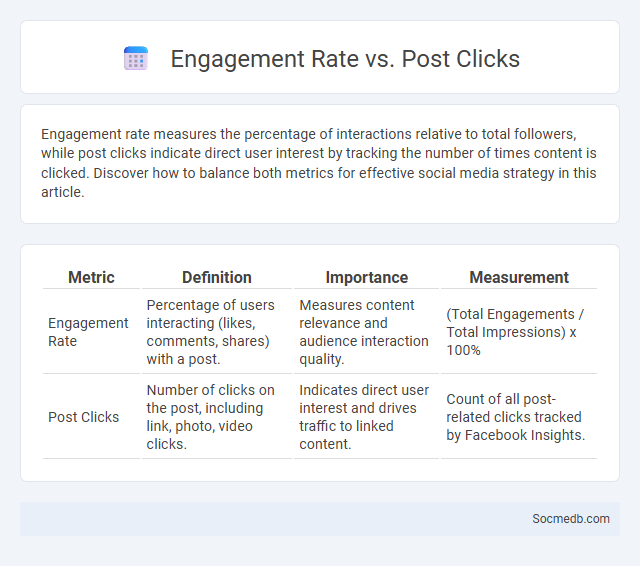
Photo illustration: Engagement Rate vs Post Clicks
Engagement rate measures the percentage of interactions relative to total followers, while post clicks indicate direct user interest by tracking the number of times content is clicked. Discover how to balance both metrics for effective social media strategy in this article.
Table of Comparison
| Metric | Definition | Importance | Measurement |
|---|---|---|---|
| Engagement Rate | Percentage of users interacting (likes, comments, shares) with a post. | Measures content relevance and audience interaction quality. | (Total Engagements / Total Impressions) x 100% |
| Post Clicks | Number of clicks on the post, including link, photo, video clicks. | Indicates direct user interest and drives traffic to linked content. | Count of all post-related clicks tracked by Facebook Insights. |
Understanding Engagement Rate: Definition and Importance
Understanding engagement rate is crucial for evaluating your social media performance, as it measures the level of interaction your content receives relative to your audience size. This metric includes likes, comments, shares, and clicks, providing insights into how effectively your posts resonate with followers. Monitoring your engagement rate helps optimize content strategies, increase brand awareness, and drive meaningful connections with your target audience.
What Are Post Clicks? A Comprehensive Overview
Post clicks refer to the total number of times users interact with a social media post by clicking on any part of it, including links, images, videos, or call-to-action buttons. Tracking post clicks provides valuable insights into audience engagement and the effectiveness of content in driving traffic or conversions. Accurate measurement of post clicks helps marketers optimize campaigns by understanding which elements resonate most with their target audience.
Engagement Rate vs Post Clicks: Key Differences
Engagement rate measures the overall interactions (likes, comments, shares) relative to the audience size, reflecting content resonance and community involvement. Post clicks indicate the number of times users interact by clicking on links, images, or videos, highlighting direct interest and traffic generation. Understanding the distinction helps optimize social media strategies for brand awareness versus lead conversion.
Why Engagement Rate Matters for Social Media Success
Engagement rate directly reflects how actively Your audience interacts with social media content, signaling content relevancy and brand resonance. High engagement rates lead to increased algorithmic visibility, boosting reach and attracting potential followers or customers. Tracking engagement rate provides actionable insights to refine social media strategies for sustained success and growth.
The Role of Post Clicks in Measuring Campaign Performance
Post clicks serve as a critical metric in social media marketing, directly reflecting user engagement with specific campaign content. This data helps marketers evaluate the effectiveness of advertisements by tracking the number of users who interact with posts and visit targeted landing pages. By analyzing post click rates alongside conversion metrics, businesses can optimize ad targeting, improve content relevance, and maximize return on investment (ROI).
How to Calculate Engagement Rate and Post Clicks
Engagement rate is calculated by dividing the total interactions (likes, comments, shares) on a post by the total number of followers, then multiplying by 100 to get a percentage. Post clicks refer to the number of times users click on links, images, or any clickable elements within a social media post. Tracking engagement rate and post clicks helps measure content effectiveness and audience interaction for platforms like Instagram, Facebook, and Twitter.
Interpreting Engagement Metrics for Better Insights
Interpreting engagement metrics such as likes, shares, comments, and click-through rates provides critical insights into your audience's preferences and behavior on social media platforms. Analyzing these data points helps you identify which content resonates most effectively, allowing for strategic adjustments to enhance user interaction and campaign performance. Leveraging advanced analytics tools can reveal deeper patterns and trends, enabling more informed decisions to optimize future social media strategies.
Common Mistakes When Comparing Engagement Rate and Post Clicks
Common mistakes when comparing engagement rate and post clicks include treating these metrics as interchangeable indicators of content performance, despite their distinct roles in measuring audience interaction. Engagement rate captures the proportion of users interacting with a post, encompassing likes, comments, and shares, while post clicks specifically track the number of times users click on links or post elements. Misinterpreting these differences can lead to inaccurate assessments of social media strategies and ineffective optimization efforts.
Optimizing Content for Higher Engagement and Clicks
Optimizing social media content for higher engagement and clicks involves using targeted keywords, compelling headlines, and visually appealing images to capture audience attention. Incorporating clear calls-to-action (CTAs) and leveraging platform-specific algorithms enhance visibility and interaction rates. Consistent analysis of engagement metrics like click-through rates (CTR) and shares allows for ongoing refinement of content strategy to maximize reach and effectiveness.
Choosing the Right Metric: Engagement Rate or Post Clicks?
Choosing the right metric between engagement rate and post clicks depends on your social media goals, as engagement rate measures how actively users interact with your content through likes, comments, and shares, while post clicks indicate direct interest and traffic driven to your links. Your business should focus on engagement rate to build community and brand loyalty or prioritize post clicks to boost conversions and website visits. Analyzing these metrics in context helps optimize your content strategy and maximize ROI on social media campaigns.
 socmedb.com
socmedb.com